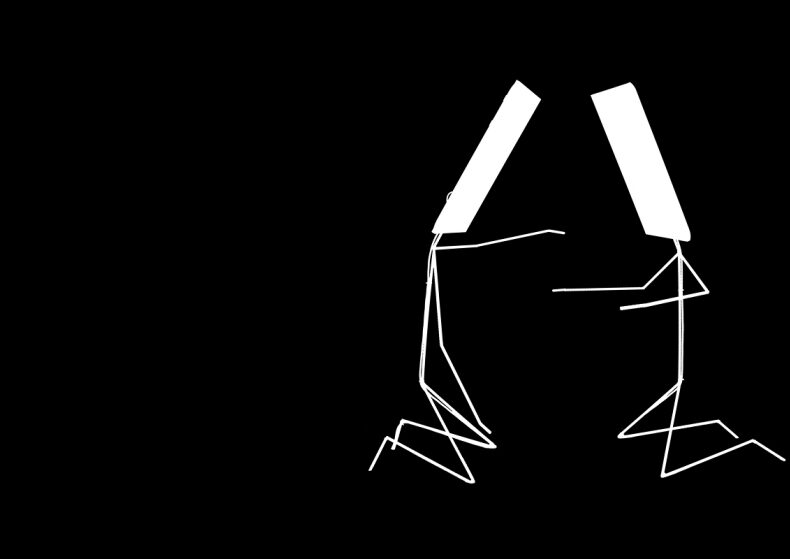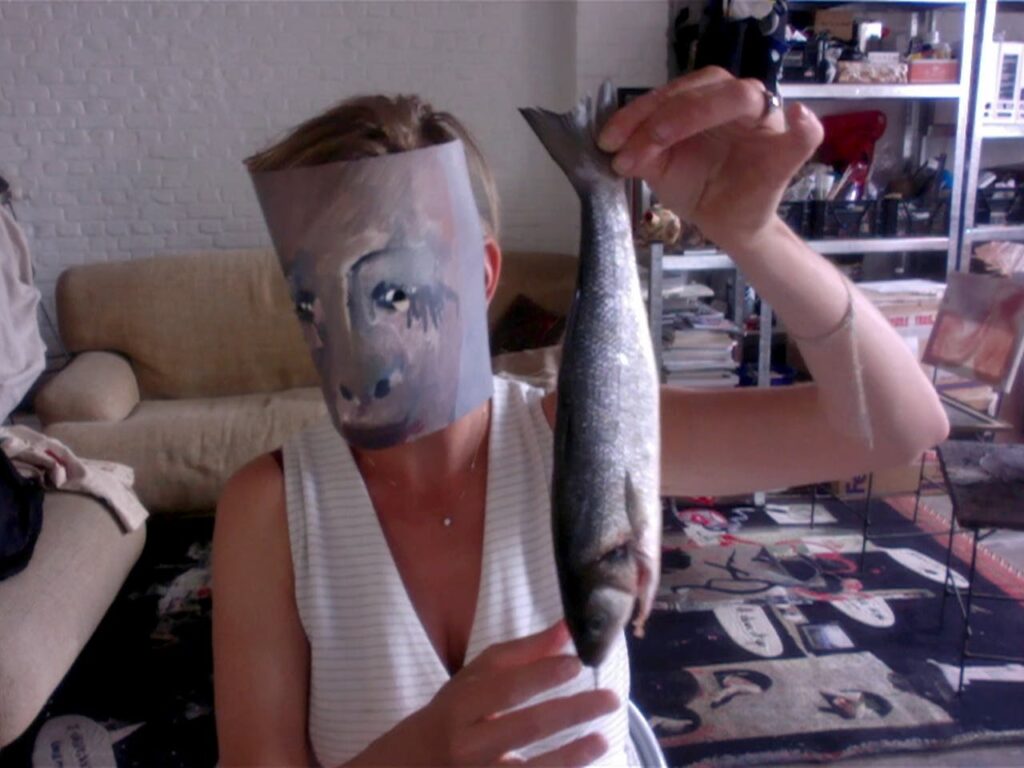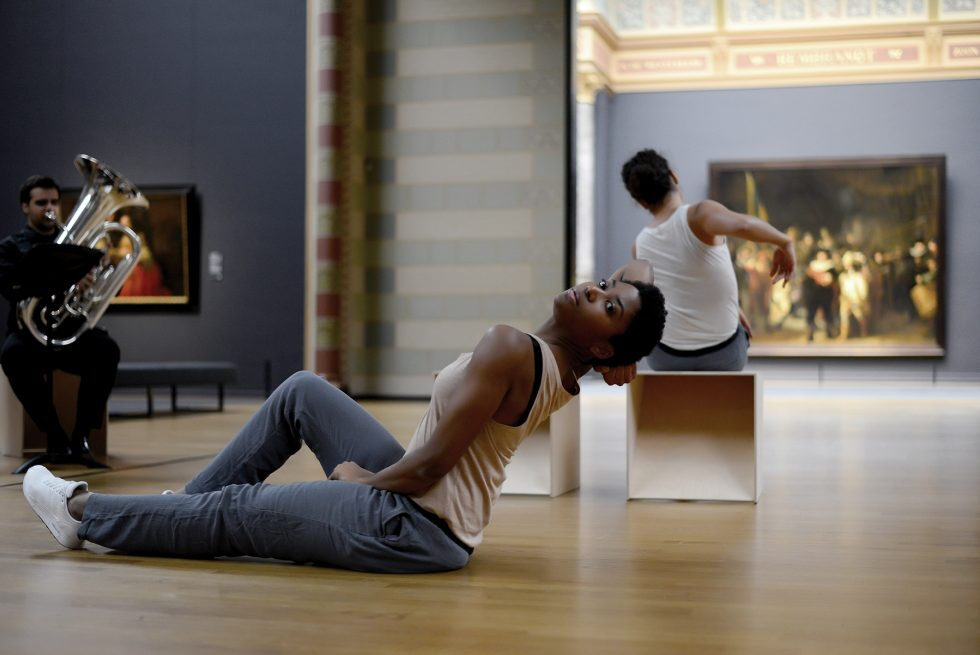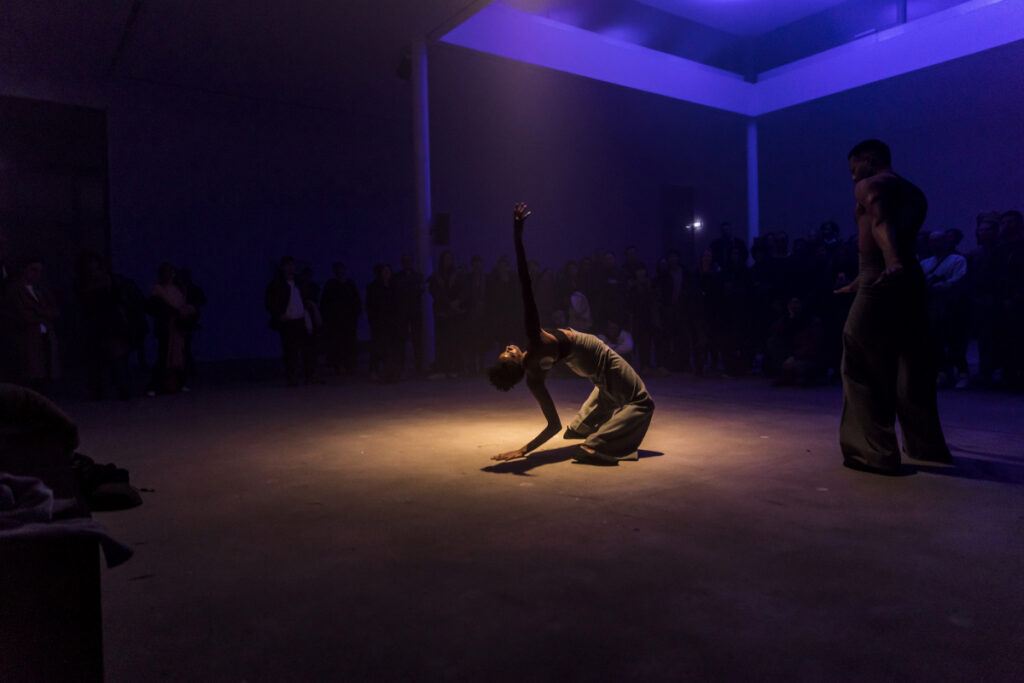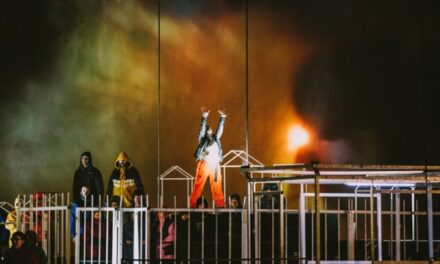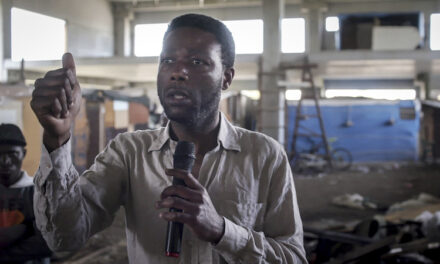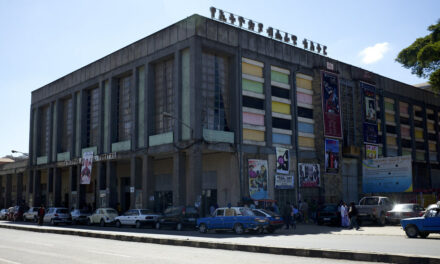The politics of (dis)association
The sixth edition of Performatik, the Brussels Biennale for “live art,” this year continues with its legacy to explore the interface between performing arts and visual art in today’s artistic practices. While the fourth edition focused on the disruption of viewing positions inherent to cross-boundary practices, and the fifth on the shrinkage of social space and how live art could make use of the body to intervene with “social sculpting,”Performatik19 is more ambitious than ever. The 2019 curatorial, while keeping the preoccupations of the previous editions intact, foregrounds two related elements integral to the field. On the one hand, the performativity of performance and the possibility to intervene in that condition where authority governs articulations usually taken as “natural.” On the other, the unraveling of the disciplinary boundaries which separate different fields in the arts as well as the institutional spaces in which they are embedded, hence its emphasis on trans-disciplinarity. This includes the undoing of the dividing lines between stage, museum, gallery, the outdoor public space, and everyday life.
This curatorial’s direction of attention to the disciplinary power which dictates the performative, normative association between the signifier and the signified as well as the boundary between disciplines and institutional spaces resuscitates the waning agency of “performance” in the arts and visual culture. Etcetera editors, dramaturgs and educators Frederik Le Roy and Kristof van Baarle, in the extended salon entitled “Indisciplinary Measures” which is part of the festival, cites W. J. T. Mitchell’s assessment of interdisciplinary practices in the arts to warn that this type of practice has lost its edge due to the re-centralization and re-institutionalization of these practices which has turned them into post-Fordist labor and modes of consumption whereby consumers shift their preference in consumption from commodified objects to experience. The two dramaturgs, however, urge practitioners to remain critical in their intent and think of interdisciplinarity, as Mitchell advocates, more as “forms of ‘indisciplineJimmy Robert – Joie Noire (c) Frank Sperling’ of turbulence or incoherence at the inner and outer boundaries of disciplines”; as the ‘anarchist’ moment which disrupts continuity whereby the practice comes into question.[1]
This salon’s reminder and invitation prepares the audience well for a festival whose aim is to explore how artists choose a particular form to present the content or experience they want to convey. It points out what is at stake in this transdisciplinary, and pleads to embrace a greater degree of criticality and remind of the potentialities of an indisciplinary trajectory. This review follows up on these key questions, especially in relation to performativity, the authority which dictates social performance learned at school, in the family and through the media [2], and the institutional spaces which these indisciplinary practices seek to break away from. Focusing on one of the nuances of the meaning of “performative”—which Catherine Wood teases out in her recent book Performance in Contemporary Art [3]—which is “to succeed”, this review pivots on the question as to what these indisciplinary practices achieve and how they mobilize the audience in particular ways.
Wood, who discusses her recent book at the opening salon of the festival by the same name, notes how language importantly informs the concept of “performativity”, especially how we imagine the I, We, and It,[4] which, in turn, governs our perception of our own subjectivity and production of the other’s otherness. Performatik19 rigorously reflects on this linguistic aspect of performativity and chooses at least two shows in this trajectory to open the festival.
Laure Prouvost’s, Sam Belinfante’s and Pierre Droulers’s They Are Waiting For You at Kaaitheater, which opens the festival, extends Prouvost’s artistic practice—one major aspects of which seeks to obscure the threshold between artworks and everyday objects outside the remit of art as seen in the mixed media installation by the same name—to blur the boundary between visual art and performing art; the border between art space and stage. The French artist taps into the borderline to involve her viewers to reminisce about how these objects/images, now treated as relics, are associated to them, hence the participatory title: “They Are Waiting For You.” Yet, Prouvost’s transposition of her visual art practice to the stage immerses the audience in a defamiliarizing situation where object/image are decoupled from the usual meaning or linguistic description automatically assigned to it.
They Are Waiting For You is Prouvost’s first work for the main stage and is rooted in her film Dit Learn, which highlights the importance of seriality and context. New meanings arise when everyday objects, images, and texts are given new contexts and sequences to create new ways of association, which, in turn, gives way to new meanings. A water cup becomes the signifier for “mother”, a shoe becomes a car, an orange stands for “excitement” and a goat for “you”, that is: us. Prouvost’s semiotic play with everyday objects reminds one of Martha Rosler’s 1975 Semiotic of the Kitchen—a performance in which Rosler parodies television cooking demonstrations in the 1960s which, for Rosler, are key in transforming women into “a sign in a system of signs that represent a system of food production, a system of harnessed subjectivity.” [5]
Feminist politics shot through the strategy of “dissociation” is also adopted by Bryana Fritz. In Submission Submission, at Beursschouwburg, Fritz reinvents dance by reconfiguring it as a space to escape from bodily choreography as we know it. Except in the beginning where she shifts the audience’s attention from the body as usual to a freakish ritual of fake-tongue stretching, she delegates her performance, hence exposing the performativity of it, to the bitmaps on the computer screen. This is whereby she turns the computer into her studio and the digital cells into the performer’s body. In more experimental sections of the show, realistic representation of the body on screen is replaced by different alignments of Apple’s Finder folders labeled after different parts of the body such as arm, leg, pussy, shoulder, back. Through this digital dissection of the body, the artist exposes the constructedness of the visual representation on screen—an antidote to realism’s suspension of disbelief, especially when one takes pleasure in pornographic film where one totally gives oneself in, which is what the audience is put through to experience in the last section of the show.
This emphasis on the constructedness of the performing body is mobilized together with Fritz’s disassociation of linguistic signs, referring to four women saints, from the sacred narratives that usually surround them. Instead, Fritz, queering hagiography, gives her audience a new unusual way to experience female “saintliness.” Based on this rewriting, the show is divided into four sections: “Christina of Bolsena” who “blind[s] the turd;” “Hildegard of Bingen” whose poetry touched on “watery varieties of sounds and silences;” “Christina the Astonishing” who “must be possessed to make sense” and “Joan of Arc” whose “name is on the lips of the entire country”. Inasmuch as Fritz uses the digital body to reinvent dance, she also intervenes into our dead language where no thinking is no longer thought necessary. Her portmanteaus on screen activate our attention to how language acquires its meaning which we usually take for granted as self-evident. A transformation from “smash hit” to “smash it” which finally resolves to “shhhhit,” for instance, speaks of the artist’s linguistic activism. Entitling her show Submission Submission, Fritz’s decoupling of the signifier from the usual signified which we, more often than not, adopt almost automatically, suggests that the fact that “meanings” and association are passed down without us thinking quite too much about them is, in fact, a form of “submission” to the patriarchal authority which determines not only the genre of hagiography, but also the language(s) we speak. This is especially representative of the mythic narratives of hagiography which Fritz effectively makes reference and intervene into this show.
With her linguistic activism, Fritz refuses to “submit” herself as an author who follows language as usual whereby she would, in turn, submit her audience to automatic association. Therefore, her strategy of “disassociation” is a strategy of subversion of the authority which governs language—an emancipation where women are given not only voices and means to speak, hence the raison d’être of the fake tongue and the corresponding labia in the last section flaunting the sexually-supercharged “Joan of Arc” engaging in lesbianism. With disassociation, these women saints also get to be represented, arguably, outside the remit of automatic association usually embedded in patriarchal reasoning, in this case, through Fritz’s subversive poetry where words and ideas that have never been used together before are lumped ensemble for defamiliarization. However, I still wonder whether it could be that Fritz’s embrace of lesbianism and its pornography as an antidote against patriarchy and its narratives might still feed on the male gaze after all.
Dissociation as a means to expose the politically-charged constructedness of visual representations, especially that of Eurocentric patriarchy is also central to Alexis Blake’s Allegory of the Painted Woman, at Bozar, which closes the festival. The anecdote as to how the project began first as a research on the representation of the female body in art history, which is then developed into a choreography and, finally, into a performance, very well speaks for the festival’s trajectory to foreground indisciplinarity, or at least interdisciplinarity, of art practices. In this performance, Blake extracts a series of repetitions of postures she found in a thousand of paintings and sculptures of the female body from Italian Renaissance to the beginning of Modernism upon her visit to galleries in Rome. This has boiled down to 48 poses which were coalesced into one sequence of movements which the two dancers then embody and act out in the performance. Blake reasons in two salons in the festival which include her work in the conversations that by stripping these poses of their original history and context and transposing them onto the body of the two dancers she works with, she wants to dismantle the historical fixity on gestures predominantly created and seen through a male gaze.
This attempt to use gestural reproduction to affect performativity and create distance between a set of signifiers and its automatically-given meanings is assisted by the staccato rhythm and jarring sound from woodwind instruments which accompany these transpositions and re-embodiments. The musical intervention creates the subversive mood of burlesque which prevents these re-embodiments from being perceived simply as “natural.” With Blake’s assumption that these poses were informed by patriarchy, hence the male gaze, giving the power to re-embody these poses to women themselves can, arguably, be an act of empowerment. The fact that Blake chooses one black and one white performer to carry out these re-embodiments has an important role in further creating the distance between the signifier and its meaning which is governed not only by patriarchy but also Eurocentrism. In the beginning of the performance, Blake aptly gives Nafisah Baba, the black female performer, a role reversal whereby she has taken an active and authoritative role in summoning the presence—through performativity—of each character in art history whose indicative gesture is embodied and acted out by Marika Meoli, the white female performer. Later in the performance, their embodiments of these extracted gestures mirror and mimic one another.
Whether or not the body of the black performer, compared to the white one, creates a greater distance between the signifier and the targeted signified, which predominantly are white women saints (such as Magdalene, Cleopatra, Theresa and Susanna) in the original historical context of production and viewing, hence a more effective disruption, is subject to further debate. The common reference to women saints and the mutual engagement with feminist politics which Blake and Fritz share in their transdisciplinary practices—which interweave paintings, dance, and music (Blake); poetry, narratives, dance, the digital and the computer screen (Fritz) together—gives the curatorial selection a well-thought-out and nuanced coherence.
While a strand of shows in the festival pivots on dissociation as a means to rethink power relations in the ready-made semantic of the visual, another strand which centers on identity politics does the opposite: engaging with the audience by means of association. Color and lighting, as the titles of both shows at Kaaistudio’s clearly designate, play important roles in both Joie Noire by Jimmy Robert and I ride in colour and soft focus, no longer anywhere by Jamila Johnson-Small who goes by the name “Last Yearz Interesting Negro.”
While Robert fully immerses his audience, himself and his co-performer Courtney Henry in the pool of electric blue light to conjure up the referential world of club culture, Last Yearz Interesting Negro mobilizes, amidst darkness, varied colors and rhythmic turns of lighting and its unsettling angles to complement the literally breath-taking flow of bodily jerks which defines her enigmatic dance. This palette of bodily movements, color, light and sound is not meant to affect any kind of referential signified, but a particular set of effect and emotions realized through personal association of what this mix of signifiers mean to each of the audience.
Without anticipating how the audience might respond to her meditative dance, Last Yearz Interesting Negro is more interested in how, in her own words, “to cultivate a space that invites something—an atmosphere, an intimacy—and then I respond in the performances (which all work with improvisation) to the ways in which the different audiences choose to interact.” [6] The interaction between the performer and the audience not only means that the artist needs her audience for the work to exist and that they are part of the work. The fact that she has to improvise according to how the bodies in front of her react to whatever she is offering, revealing, sharing and giving to them means that she is “navigating ‘the gaze’…which is survival work that all ‘othered’ bodies are obliged to do. As a black woman born and raised in a majority white country with a ‘history’ of Empire, I am always aware of my audience…. For me, this spoke to the oftenoscillating nature with which ‘othered’ bodies relate to ‘the gaze’.” [7]
Also an act which pivots on the notion of the “other” and a tribute to artist and curator and Robert’s former collaborator Ian White who died in 2013, Joie Noire takes as its point of departure the politics of being different and the visibility of that mode of being. In an interview with Eva Decaesstecker for Kaaitheater, Robert explains that for him White stood out “because he epitomized a form of being gay which was uncompromising, which then felt very political.” [8] The club world is a space which accommodates the politics of being different: non-white and non-heteronormative, and that of visibility. Disco and nightclubbing, reveals Robert, is “a space created out of necessity for a segment of the population who could not express their sexuality and desire outside and needed to find a space where this could happen.” [9] The fact that Robert chooses to use the blue color to evoke that particular world to the audience might seem and may be a random choice. But for those familiar with the late film director Derek Jarman’s last work Blue (1993) released before his death from AIDS-related complications, saturating the space with the blue color and filling it with narratives on different deaths from AIDS in the 1980s confirms the affective power of association the blue color as a signifier has on a particular cultural context, which, in this case, is the Euro-American gay cultural world. Especially in the context of Jarman’s last film—whose single shot of saturated blue color permeates the screen as a background to which Jarman and his friends narrate the artist’s life and vision—blue is the color which is closely related to “invisibility.” The AIDS-related complications had, in fact, rendered Jarman partially blind, hence his ability to see only in shades of blue. Deploying blue in this context surrounding AIDS is, therefore, rich in its multiple layers of meaning pertaining to otherness and the politics of visibility which is also central to Joie Noire. Indispensably intertwined with the politics of sight is the space in which change can be affected to give visibility to those earlier not visible. In Joie Noire, Robert cunningly incorporates the festival’s preoccupation with transdisciplinarity and its attempts to dissolve disciplinary boundaries separating institutional spaces, such as museums and galleries, and non-institutional spaces, such as club scenes, from each other. This spatial merger is achieved by, at one point, turning the “dance floor” into an “exhibition space” whereby he and his co-performer transform themselves from mobile dancers to an image in a photograph—the stillness and “silence” of which somehow bewilder some audience who are lost trying to grasp the meaning of such abrupt ontological turn of space. Thinking in this light, Joie Noire is a product of an indisciplinary practice where the artist combines a spatial turn in contemporary art to effect an institutional critique whose aim is to challenge the authority which determines the hierarchies which dictate what is to be seen and included in the institution (museums and exhibition space) or excluded outside it (the club world).
Other works in the festival which seek to dismantle the dividing line between different mediums of art including painting, sculpture and performance; the border between art and politics and the institutional spaces in which they are embedded include Ula Sickle’s & Hyoid’s Voice ascending a staircase at Wiels; Jocelyn Cottencin’s Monumental and at Kanal—Centre Pompidou and Gluklya & Anna Bitkina’s Debates on Division When Private Becomes Public at Bozar, among others. But it is Noé Soulier’s Performing Art at Kaaitheatre which brings this in-/trans-/inter-disciplinary trajectory of the festival to its culmination.
There is something intriguingly “grand” about Soulier’s show. Maybe it’s the institutional aspect of the project; the fact that it has to deal with not only real art objects from world-renowned collections of the Centre Pompidou, but also the institutional consent behind the project which makes this spatial transposition from the museum to the Kaaitheatre and elsewhere possible. Perhaps it’s the fact that the people on stage are not actors and actresses but real art handlers and exhibition registrars who have worked together to realize countless real exhibitions at the institution. Or perhaps it’s because of the silence and the well-timed rhythm of movements of how the artworks and the cultural workers beautifully coalesce in and out of the spectacle.
Whatever it is, like all other shows in this edition of the festival which seek to push the disciplinary and institutional boundaries, Soulier’s work poses the same question, but for some reason with greater momentum, as to what the purpose of this indisciplinarity is. Or maybe the quest for a purpose is not necessary at all as how each person relates and responds to the spectacle in front of him and her and the experience in which he or she is embedded varies from one person to another? But if there is a purpose, how do these in- / trans- / inter-disciplinary trajectories mobilize the audience in certain ways? Are there any shared political potentialities behind these practices or is it just indisciplinarity for indisciplinarity’s sake?
My preoccupation with “purpose” does come out of my experience with Soulier’s show itself. Moving art objects onto the stage not only has implications in terms of the politics of space as we have seen in Robert’s work. It significantly changes our relationship with the objects themselves and people around us because the spatial transposition releases the hidden “time” out of the objects, transforming what is usually static and isolated as a viewing experience into something durational and shared between other people watching the same performance unfolding. As Soulier puts it “While in a museum, you can watch the works at your own pace, being free to go back, in Performing Art, we look at the works with a time and an imposed point of view.” [10] If this is the way Soulier theorizes “spectacle” and “spectatorship”, there is surely a political potentiality, a kind of purpose, to this spatial transposition as it pivots on a shared position among spectators, which for philosopher Jacques Rancière is the foundation of the condition where distribution of the sensible (partage du sensible), which constitutes politics, becomes possible.
The elegance of Soulier’s work may also come from the fact that in its quiet and minimal ways of unfolding, it sharply makes references not only to philosophical pondering about being and time [11] but also to the school of the Theatre of the Absurd whose preoccupations lie on the existentialist questions about purpose, authenticity and absurdity of existence in time—all of which is encapsulated in Soulier’s Performing Art. Despite the “grandeur” and “elegance,” Performing Art is also, in fact, at some point, very funny to the point of being absurd. Take, for instance, the length of time the art handlers spend in unfolding and installing a “green dress” out of what looks more like an endless length of fishing net. As the full seven minutes unfold “out of” the object, the fact that it seems like forever gives an uncomfortable sense of waiting for something or someone who never shows up—an unmistakable reference to Waiting for Godot. The absurdity embedded in time and existence in Performing Art becomes even greater to the point of being unbearable when crates after crates of art objects—some of which is ridiculously commonplace (objets trouvés)—are endlessly opened, vacated, loaded back in, closed, moved away and back to the beginning again. Beautifully intertwined with the absurdity of being in time in this important work is, therefore, its engagement with the politics of visibility of labor in the museum industry. By revealing time hidden in the exhibited art objects, Soulier brings the labor of cultural workers whose daily tasks resemble that of Sisyphus’s into visibility and appreciation. Along with other works in the same trajectory discussed above, these cultural workers’ performativity which is made possible by the strategic spatial and disciplinary transposition seems to suggest that the indisciplinarity as put forward by Performatik19 is, after all, full of purpose and not the opposite.
[1] W. J. T. Mitchell, “Interdisciplinarity and Visual Culture”, Art Bulletin, December 1995, Vol. LXXVII, no. 4, pp. 540-544.
[2] Catherine Wood, Performance in Contemporary Art, Tate Publishing, 2018, p. 20.
[5] https://www.moma.org/collection/works/88937
[6] Nkenna Akunna, “In Conversation with Last Yearz Interesting Negro”, June 2018.
[8] Eva Decaesstecker, “Challenging the Hierarchies”, Kaaitheatre, March 2019.
[10] Interview with Noé Soulier by Estelle Spoto, March 2019, Musée Haut, Musée Bas, (my emphasis).
[11] As famously postulated in Heidegger’s notion of dasein or being in the context of a time rather than being in an isolated sense as proposed by Descartes.
This article originally appeared in e-tcetera.be on April 10, 2019, and has been reposted with permission.
This post was written by the author in their personal capacity.The opinions expressed in this article are the author’s own and do not reflect the view of The Theatre Times, their staff or collaborators.
This post was written by Rathsaran Sireekan.
The views expressed here belong to the author and do not necessarily reflect our views and opinions.

